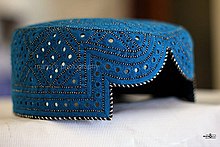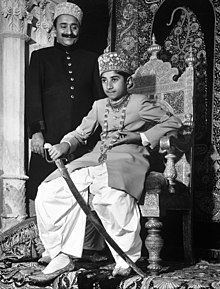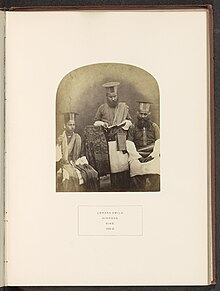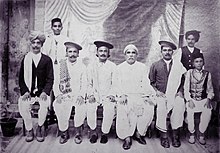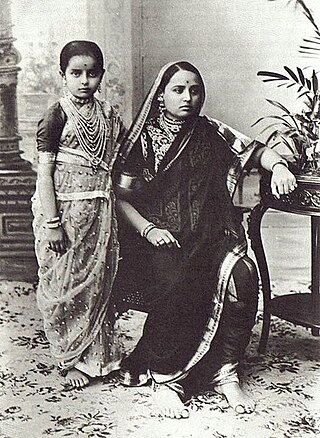
A sari is a women's garment from the Indian subcontinent, that consists of an un-stitched stretch of woven fabric arranged over the body as a robe, with one end attached to the waist, while the other end rests over one shoulder as a stole (shawl), sometimes baring a part of the midriff. It may vary from 4.1 to 8.2 metres in length, and 60 to 120 centimetres in breadth, and is a form of ethnic wear in India, Sri Lanka, Nepal, Bangladesh and Pakistan. There are various names and styles of sari manufacture and draping, the most common being the Nivi style. The sari is worn with a fitted bodice also called a choli and a petticoat called ghagra, parkar, or ul-pavadai. It remains fashionable in the Indian subcontinent today.

A kurta is a loose collarless shirt or tunic worn in many regions of South Asia, and now also worn around the world. Tracing its roots to Central Asian nomadic tunics, or upper body garments, of the late-ancient- or early-medieval era, the kurta has evolved stylistically over the centuries, especially in South Asia, as a garment for everyday wear as well as for formal occasions.
Clothing in India varies with the different ethnicities, geography, climate, and cultural traditions of the people of each region of India. Historically, clothing has evolved from simple garments like kaupina, langota, achkan, lungi, sari, to rituals and dance performances. In urban areas, western clothing is common and uniformly worn by people of all social levels. India also has a great diversity in terms of weaves, fibers, colors, and the material of clothing. Sometimes, color codes are followed in clothing based on the religion and ritual concerned. The clothing in India also encompasses a wide variety of Indian embroidery, prints, handwork, embellishments, and styles of wearing clothes. A wide mix of Indian traditional clothing and western styles can be seen in India.

A tunic is a garment for the body, usually simple in style, reaching from the shoulders to a length somewhere between the hips and the knees. The name derives from the Latin tunica, the basic garment worn by both men and women in Ancient Rome, which in turn was based on earlier Greek garments that covered wearers' waists.

The dupattā, also called chunni, chunari,chundari, rao/rawo, gandhi, pothi and odhni is a long shawl-like scarf traditionally worn by women in the Indian subcontinent to cover the head and shoulders. The dupatta is currently used most commonly as part of the women's shalwar kameez outfit, and worn over the kurta and the gharara.

A choli is a blouse or a bodice-like upper garment that is commonly cut short leaving the midriff bare, it is worn along with a sari in the Indian subcontinent. The choli is also part of the ghagra choli costume in the Indian subcontinent.

Punjabi culture grew out of the settlements along the five rivers which served as an important route to the Near East as early as the ancient Indus Valley civilization, dating back to 3000 BCE. Agriculture has been the major economic feature of the Punjab and has therefore formed the foundation of Punjabi culture, with one's social status being determined by landownership. The Punjab emerged as an important agricultural region, especially following the Green Revolution during the mid-1960's to the mid-1970's, has been described as the "breadbasket of both India and Pakistan". Besides being known for agriculture and trade, the Punjab is also a region that over the centuries has experienced many foreign invasions and consequently has a long-standing history of warfare, as the Punjab is situated on the principal route of invasions through the northwestern frontier of the Indian subcontinent, which promoted to adopt a lifestyle that entailed engaging in warfare to protect the land. Warrior culture typically elevates the value of the community's honour (izzat), which is highly esteemed by Punjabis.

Ajrak, also known as Ajrakh, is a unique form of textile block-printing found primarily in Sindh, Pakistan and the village of Ajrakhpur in the bordering Kutch district of India. Ajrak textiles like shawls or dresses display special designs and patterns made using block printing with stamps. Ajrak is a symbol of Sindhi culture and traditions. Ajrak prints are also famous in neighbouring areas of India, in Gujarat, due to their influence from the Indus Valley civilization. Apart from Sindh and Kutch, recently, a Saraiki version of the Ajrak called Sajarak was created and is found in South Punjab, Pakistan.

Ghagra choli is a type of ethnic clothing for women from the Indian Subcontinent, notably in the Indian states of Rajasthan, Gujarat, Madhya Pradesh, Uttar Pradesh, Bihar, Haryana, Punjab, Himachal Pradesh, Uttarakhand, Jammu and Kashmir, as well as in the Pakistani provinces of Punjab and Sindh. In Punjab, the lehenga is traditionally worn with a kurti. It is a combination of the gagra or lehenga and the choli (blouse), however in contemporary and modern usage lehenga choli is the more popular and widely accepted term by fashion designers, trend setters, and boutiques in South Asia, since ghagra is synonymous with the half-slip (petticoat) worn as an undergarment below the sari.
Pakistani clothing refers to the ethnic clothing that is typically worn by people in the country of Pakistan and by Pakistanis. Pakistani clothes express the culture of Pakistan, the demographics of Pakistan, and cultures from Punjab, Sindh, Balochistan, Khyber Pakhtunkhwa, Gilgit-Baltistan, and Kashmir regions of the country. The clothing in each region and culture of Pakistan reflect weather conditions, way of living, the textiles and embroidery used and its distinctive style which gives it a unique identity among all cultures.

Shalwar kameez is a traditional combination dress worn by men and women in South Asia, and Central Asia.

The Sindhi cap, locally called Sindhī ṭopī rarely known as the Sindhi Kufi, is a skullcap worn predominantly by Sindhis in Sindh, Pakistan. Together with Ajrak, the Sindhi cap is regarded as an essential part of Sindhi culture.

The Punjabi ghagra is a four-piece outfit known as tewar or 'ti-or' which was traditionally worn by Punjabi women throughout the Punjab region with the outfit comprising a head scarf (Phulkari), kurta or kurti, ghagra and either a suthan or the Punjabi salwar (trousers). In modern times, the ghagra is worn by women in parts of Haryana, rural parts of south West Punjab, parts of Himachal Pradesh and during performances of Giddha in East Punjab.
Salwar or Shalwar is cloth worn from the waist to the ankles, covering both legs separately. It is the lower-garment of the Shalwar kameez suit which is widely-worn in South Asia. It is known for its lively hues, rich fabrics, and embroidery. It is also the national dress of Pakistan, and since the later 1960s with the salwar being used in government offices in Pakistan. The outfit has been a part of Punjabi tradition for centuries. Salwar can be distinguished from the Punjabi suthan which is shorter than the salwar.

In the ancient Punjab region, people wore cotton clothing. Both men and women wore knee-length tops. A scarf was worn over the tops which would be draped over the left shoulder and under the right. A large sheet would be further draped over one shoulder which would hang loose towards the knees. Both male and female wore a dhoti around the waist. Modern Punjabi dress has retained this outfit but over its long history has added other forms of dress.

History of clothing in the Indian subcontinent can be traced to the Indus Valley civilization or earlier. Indians have mainly worn clothing made up of locally grown cotton. India was one of the first places where cotton was cultivated and used even as early as 2500 BCE during the Harappan era. The remnants of the ancient Indian clothing can be found in the figurines discovered from the sites near the Indus Valley civilisation, the rock-cut sculptures, the cave paintings, and human art forms found in temples and monuments. These scriptures view the figures of human wearing clothes which can be wrapped around the body. Taking the instances of the sari to that of turban and the dhoti, the traditional Indian wears were mostly tied around the body in various ways.

The traditional clothing and accessories worn in Khyber Pakhtunkhwa varies according to the area of the region. The following outfits are generally worn in the area, starting to north to south:
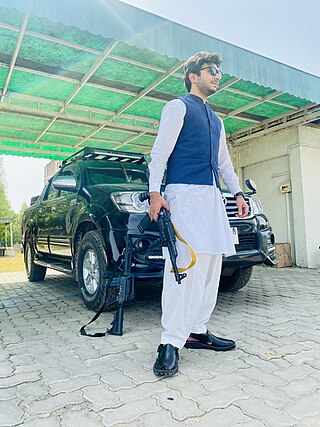
There are two types of Saraiki shalwar suits which originate in the southern area of Punjab, Pakistan. These are the Bahawalpuri shalwar suit and the Multani shalwar suit. The two main suits from that area.

Sindhi embroidery comes from the arid province of Sindh in southern Pakistan, which has always been famed for its embroidery.
The crafts of Sindh and its craftsmen are held in high esteem and their works are notable not only in Sindh but also in many other places.

















